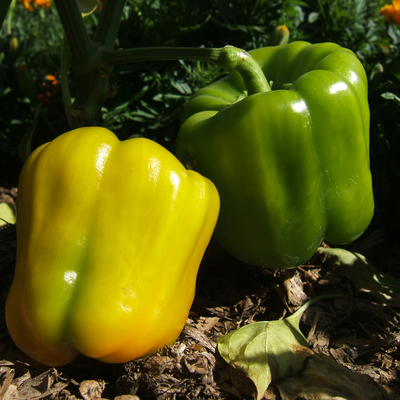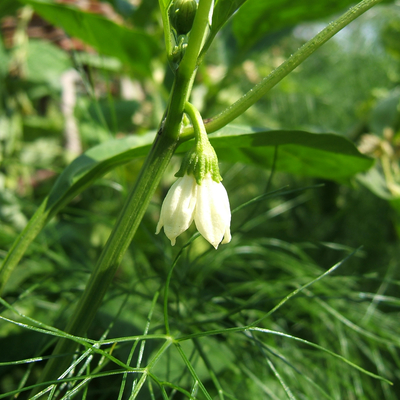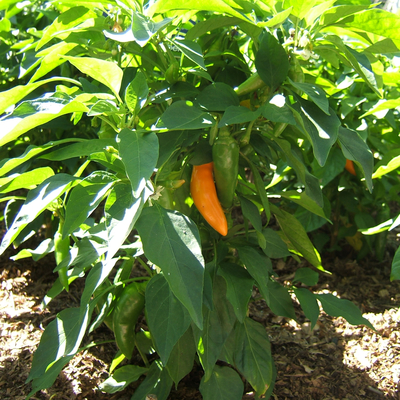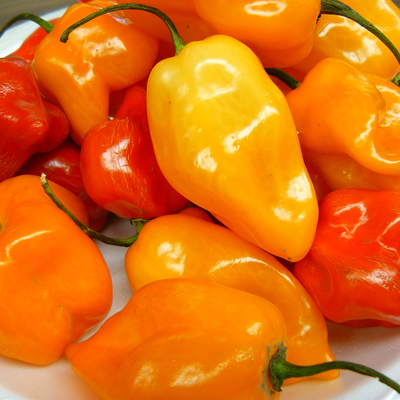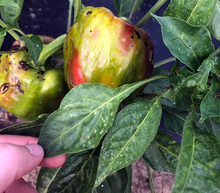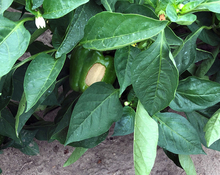A quick guide to peppers
- Start pepper from seeds indoors about eight weeks before planting outside.
- If you buy plants from a garden center, choose sturdy plants up to a foot tall.
- Transplant outdoors after nighttime low temperatures are above 50°F.
- Use black plastic mulch to warm the soil, decrease weed growth and keep soil moisture.
Peppers (Capsicum annum, C. chinense) can be sweet or hot, tiny or a foot long, and range in color from green, yellow, orange, red and purple, to brown.
Sweet peppers include banana, bell, cherry and pimiento types. Hot peppers include ancho, chili, habanero, jalapeño, hot banana and serrano types.
The compound that makes peppers taste hot is capsaicin and is in the seeds and the whitish membrane inside the fruits. Removing the seeds and membrane before cooking or eating raw reduces the hotness of peppers.
Selecting plants
- Have your soil tested to determine pH.
- Peppers do best in soil with pH between 6.5 and 7.
- Apply phosphorus (P) and potassium (K) according to soil test recommendations. Many Minnesota soils have enough phosphorus.
- Unless your soil test report specifically recommends additional phosphorus, use a low- or no-phosphorus fertilizer.
- Too much nitrogen fertilization will lead to plants that are bushy, leafy and slow to bear fruit.
- Do not use any fertilizer containing a weed killer ("Weed and Feed"), as it may kill your vegetable plants.
- Improve your soil by adding well-rotted manure or compost in spring or fall. Do not use fresh manure as it may contain harmful bacteria and may increase weed problems.
If you buy plants from a garden center, choose sturdy plants up to a foot tall. The garden center should have stems at least the width of a pencil and the leaves should be closely spaced up the stem. Do not buy plants with spots on their leaves, which could increase the chance of diseases in your garden.
If you buy plants from a mail-order catalog, you may need to keep them indoors until it is time to set them out. Treat them as if you had started them yourself.
Choosing varieties suited to Minnesota
Check the “Days to Maturity” or “Days to Harvest” estimate in the seed or plant description.
Look for peppers described as “widely adapted” and “cold tolerant.” Some seed catalogs will classify their offerings, pointing out varieties that are the best choices for northern gardeners.
In general, smaller-fruited peppers are more tolerant of both cool and hot temperatures, so while you may enjoy the challenge of growing big bell peppers, planting some smaller sweet peppers will result in a more satisfying harvest.
Disease resistant varieties
- If you have previously identified disease issues in the garden, choosing a resistant or tolerant variety is a good way of preventing the disease in the future.
- A resistant variety will not become diseased.
- A tolerant variety will become diseased, but spread of disease will be slower and the infection will be less serious
- Seed catalogs use codes to note which varieties of peppers are resistant or tolerant to different diseases.
- Some garden centers and big box stores include this information in their signage.
- For a full list of varieties, see the Cornell University Disease Resistant Vegetable Varieties page.
Planting
Start pepper seeds about eight weeks before planting outside. This is earlier than you would normally start tomato seeds.
- Plant seeds one-fourth inch deep in flats containing sterile, soilless germination mix.
- Use a heating mat to keep the flat at 80°F to 90°F until seedlings emerge. Monitor potting mix moisture, as heating mats will dry the mix out faster.
- A soil temperature of 70°F is ideal. Warm soil is better than cool.
- Provide bright overhead light for the seedlings.
- Thin or transplant seedlings after true leaves appear so that seedlings are two to three inches apart. Without enough bright light directly overhead, the stems of the little plants will elongate and lean over.
- Pepper plants may start to flower while still indoors. Pinch off the clusters of flower buds until just before you will set the plants out in the garden.
- Reduce watering when plants are four to five inches tall, and six to eight weeks old.
- Place plants outside where they will receive wind protection and a couple hours of sunlight.
- Gradually expose them to more sunlight over the next week or two, bringing them indoors if night temperatures drop below 55°F.
White flower on sweet pepper plant
Location
- Choose a location in your garden where you have not grown tomatoes, potatoes, peppers, eggplants and tomatillos for the past three or four years.
- Space pepper plants 18 inches apart, in rows 30 to 36 inches apart.
- Grow plants closer together if temperatures are below 60°F. Closer spacing requires fertilizer at planting and during the summer.
Climate
- Transplant outdoors after nighttime low temperatures are above 50°F.
- Dry soil, temperatures above 90°F, or night temperatures below 60°F or above 70°F, can weaken plant growth.
- Transplant in late afternoon or on a cloudy, calm day.
- Pepper flavor is best when the season has been warm and sunny. Fruit that matures under cool or cloudy conditions will not be as tasty.
- Fruits are also vulnerable to sunburn. They develop white patches if there is not enough leaf surface to cover fruit and protect them from sunlight during hot, dry weather.
Treatment
- Water plants well before transplanting.
- Transplant seedlings grown in separate containers without disturbing the roots.
- When transplanting seedlings in peat pots, do not expose the top edge of the peat pot above the soil surface, or the peat pot will act like a wick and rapidly draw the moisture from the root ball, stressing the plant.
- Set pepper seedlings out in the garden so that the shoots are at the soil line as they were before transplanting.
- With a hand shovel, make a hole large enough for the root ball of the transplant.
- Firm the soil around the roots and water the transplant.
How to keep your pepper plants healthy and productive
- Consistent soil moisture levels produce the best quality fruit. Poor soil moisture levels weaken flowers and small fruits, and peppers are vulnerable to blossom-end rot.
- Avoid overhead sprinkling. Wet leaves are more disease prone. Soil splashed up onto the leaves can contain disease spores.
- A light sprinkling that just wets the surface of the soil can cause shallow root development, increase the crop’s vulnerability to hot weather and drought stress, and reduce fruit quality.
- If the plant does not receive one inch of rain weekly, soak the soil thoroughly at least once a week.
- If your soil is sandy, it is important to water more often than once a week.
- Frequent, shallow cultivation with a garden hoe or trowel will kill weeds before they become a problem.
- Cultivate just deeply enough to cut the weeds off below the surface of the soil.
- Peppers benefit from black plastic mulch that warms the soil, decreases weed competition and keeps soil moisture.
- Mulching with herbicide-free grass clippings, weed-free straw or other organic material to a depth of three to four inches can help prevent weed growth, decreasing the need for frequent cultivation.
- Wear gloves when picking hot peppers. Wash your hands after touching hot peppers, before using the bathroom or touching your eyes. Even sweet peppers may contain enough capsaicin to irritate skin.
- Harvest peppers when they have reached mature size.
- You do not need to wait for peppers to turn red before harvesting. Many varieties have good quality when green, as well as when ripened. For example, jalapenos can be used when green and Hungarian wax peppers when yellow.
- Some varieties of pepper bear fruits that will separate easily from the plant. Harvest most peppers by clipping the stem of the fruit with sharp shears.
- As you continue to harvest, the plants will continue to produce flowers and set more fruit.
- Peppers will keep for a week or more in the refrigerator. They are sensitive to the cold, and their skins may become pitted after too long under refrigeration.
- There are many ways to preserve your pepper harvest.
Managing pests, diseases, and disorders
Many things can affect pepper leaves, flowers and fruit. Changes in physical appearance and plant health can be caused by the environment, plant diseases, insects and wildlife. In order to address what you’re seeing, it is important to make a correct diagnosis.
You can find additional help identifying common pest problems by using the online diagnostic tools or by sending a sample to the UMN Plant Disease Diagnostic Clinic. You can use Ask a Master Gardener to share pictures and get advice.
- Cutworms chew stems at the soil line, leaving the severed tops uneaten.
- Aphids can colonize pepper plants in large numbers. You may notice leaf curling, discoloration, and sticky leaves.
- If you have aphids, you may see natural enemies nearby feeding on them.
- Tomato hornworms can chew holes in the fruit.
- Bacterial spot can cause spots on leaves and fruit.
Extreme virus infection causing patterns on the leaves, as well as discoloration and distortion on pepper fruit. - Viruses can infect peppers, causing twisted leaves and bumps on fruit. Viruses cannot be cured, and affected plants should be removed.
- Blossom end rot causes the ends of pepper fruit to not develop, leading to the “blossom end” becoming scabbed over or moldy.
A bell pepper that has developed sunscald thank to a gap in the leaf canopy. - Sunscald occurs on fruit that develop on small plants. Developing peppers can be exposed to intense direct sunlight, damaging the develop fruit and creating flat, tan areas on the peppers.
- When Minnesota has hot days and hot nights, pepper flowers can drop, leading to less fruit production.
Reviewed in 2022


